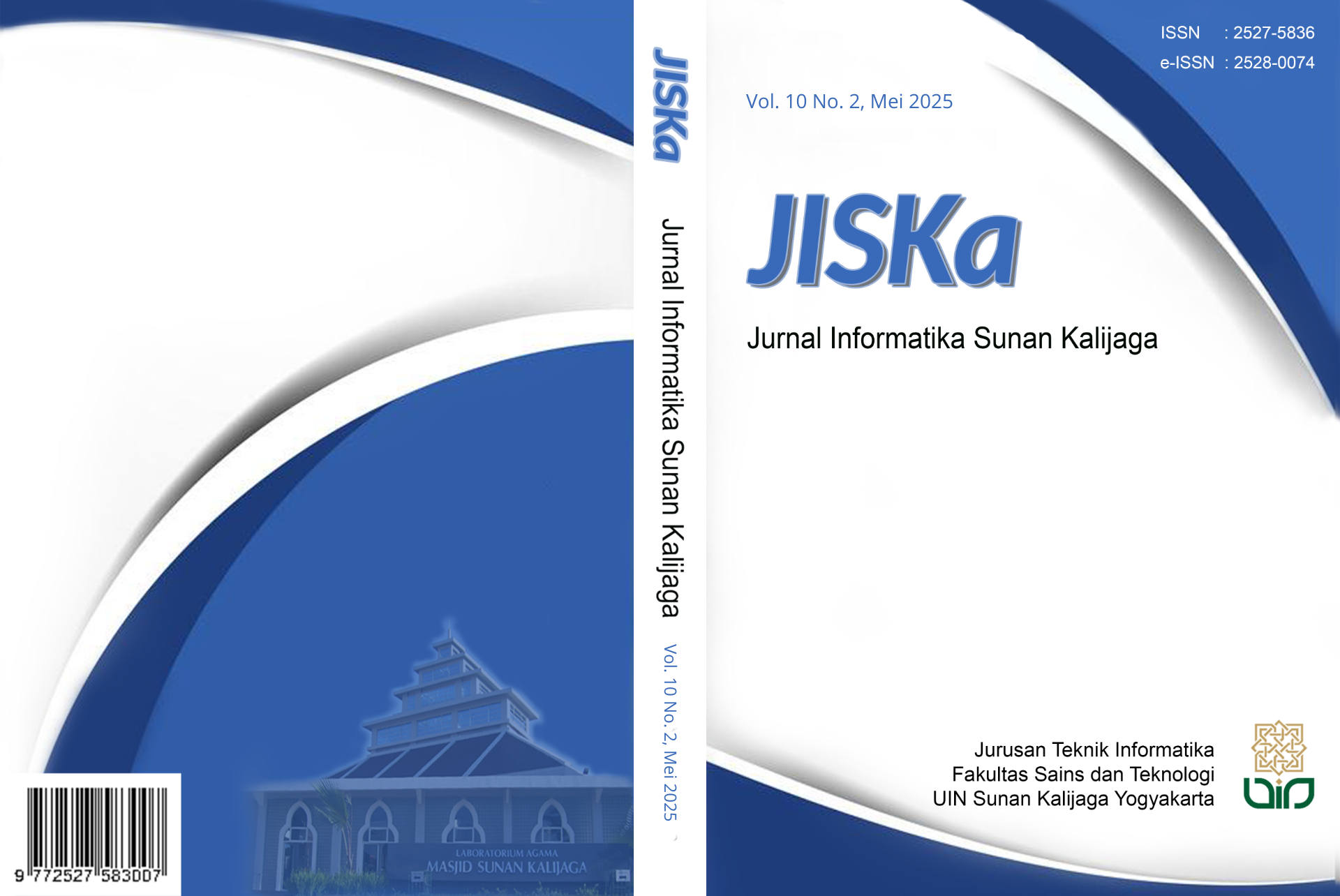Klasifikasi Penyakit pada Tanaman Berdasarkan Citra Daun Menggunakan Metode Convolutional Neural Network
DOI:
https://doi.org/10.14421/jiska.2025.10.2.235-248Keywords:
Classification, Image Classification, Convolutional Neural Network, Plant Disease, AgriculturalAbstract
The agricultural sector is a vital part of the economy, providing food, raw materials, and employment opportunities. In Indonesia, this sector faces significant challenges, such as low interest from younger generations and plant disease issues. Plant disease identification typically requires experienced experts, but this process is time-consuming and costly. This research aims to develop a plant disease classification model using Convolutional Neural Network (CNN) to assist farmers in identifying diseases in rice, corn, tomato, and potato plants based on leaf images. Testing was conducted with data splitting ratios of 70:30, 80:20, and 90:10, using both single-stage and multi-stage classification methods. The best results were achieved with an 80:20 data ratio using single-stage classification, with an average accuracy of 80%, precision of 80%, recall of 81%, and F1-score of 79%. This study demonstrates that the CNN method is effective in plant disease classification, with optimal performance at an 80:20 data ratio and single-stage classification. It is hoped that this research can help farmers quickly and accurately identify and manage plant diseases, as well as encourage innovation in the agricultural sector. The implementation of CNN in plant disease classification shows great potential in enhancing the efficiency and accuracy of disease detection, ultimately supporting the sustainability and development of the agricultural sector.
References
Ambarwari, A., Husni, E. M., & Mahayana, D. (2023). Perkembangan Paradigma Metode Klasifikasi Citra Penginderaan Jauh dalam Perspektif Revolusi Sains Thomas Kuhn. Jurnal Filsafat Indonesia, 6(3), 465–473. https://doi.org/10.23887/jfi.v6i3.53865
Anggiratih, E., Siswanti, S., Octaviani, S. K., & Sari, A. (2021). Klasifikasi Penyakit Tanaman Padi Menggunakan Model Deep Learning Efficientnet B3 dengan Transfer Learning. Jurnal Ilmiah SINUS, 19(1), 75–83. https://doi.org/10.30646/sinus.v19i1.526
Anggraeni, D. S., Widayana, A., Rahayu, P. D., & Rozikin, C. (2022). Metode Algoritma Convolutional Neural Network pada Klasifikasi Penyakit Tanaman Cabai. STRING (Satuan Tulisan Riset dan Inovasi Teknologi), 7(1), 73–78. https://doi.org/10.30998/string.v7i1.13304
Chellapandi, B., Vijayalakshmi, M., & Chopra, S. (2021). Comparison of Pre-Trained Models Using Transfer Learning for Detecting Plant Disease. 2021 International Conference on Computing, Communication, and Intelligent Systems (ICCCIS), 383–387. https://doi.org/10.1109/ICCCIS51004.2021.9397098
Felix, F., Wijaya, J., Sutra, S. P., Kosasih, P. W., & Sirait, P. (2020). Implementasi Convolutional Neural Network Untuk Identifikasi Jenis Tanaman Melalui Daun. Jurnal SIFO Mikroskil, 21(1), 1–10. https://doi.org/10.55601/jsm.v21i1.672
Guo, Y., & Wang, X. (2022). Modulation Signal Classification Algorithm Based on Denoising Residual Convolutional Neural Network. IEEE Access, 10, 121733–121740. https://doi.org/10.1109/ACCESS.2022.3221475
Hasan, Moh. A., Riyanto, Y., & Riana, D. (2021). Grape Leaf Image Disease Classification Using CNN-VGG16 Model. Jurnal Teknologi dan Sistem Komputer, 9(4), 218–223. https://doi.org/10.14710/jtsiskom.2021.14013
Irfansyah, D., Mustikasari, M., & Suroso, A. (2021). Arsitektur Convolutional Neural Network (CNN) Alexnet untuk Klasifikasi Hama pada Citra Daun Tanaman Kopi. Jurnal Informatika: Jurnal Pengembangan IT, 6(2), 87–92. https://doi.org/10.30591/jpit.v6i2.2802
Nawwar, N., Kasban, H., & Salama, M. (2021). Improvement of Confusion Matrix for Hand Vein Recognition Based on Deep-Learning Multi-Classifier Decisions. Arab Journal of Nuclear Sciences and Applications, 54(4), 133–146. https://doi.org/10.21608/ajnsa.2021.70450.1460
Oktaviana, U. N., Hendrawan, R., Annas, A. D. K., & Wicaksono, G. W. (2021). Klasifikasi Penyakit Padi berdasarkan Citra Daun Menggunakan Model Terlatih Resnet101. Jurnal RESTI (Rekayasa Sistem dan Teknologi Informasi), 5(6), 1216–1222. https://doi.org/10.29207/resti.v5i6.3607
Sabrina, S. A., & Maki, W. F. A. (2022). Klasifikasi Penyakit pada Tanaman Kopi Robusta Berdasarkan Citra Daun Menggunakan Convolutional Neural Network. EProceedings of Engineering, 9(3), 1919–1927. https://openlibrarypublications.telkomuniversity.ac.id/index.php/engineering/article/view/17997
Singh, V., & Misra, A. K. (2017). Detection of Plant Leaf Diseases Using Image Segmentation and Soft Computing Techniques. Information Processing in Agriculture, 4(1), 41–49. https://doi.org/10.1016/j.inpa.2016.10.005
Suganda, T., & Wulandari, D. Y. (2018). Curvularia sp. Jamur Patogen Baru Penyebab Penyakit Bercak Daun pada Tanaman Sawi. Jurnal Agrikultura, 29(3), 119–123. https://doi.org/10.24198/agrikultura.v29i3.22716
Tineges, R., Triayudi, A., & Sholihati, I. D. (2020). Analisis Sentimen Terhadap Layanan Indihome Berdasarkan Twitter dengan Metode Klasifikasi Support Vector Machine (SVM). Jurnal Media Informatika Budidarma, 4(3), 650–658. https://doi.org/10.30865/mib.v4i3.2181
Zalvadila, A. (2023). Klasifikasi Penyakit Tanaman Bawang Merah Menggunakan Metode SVM dan CNN. Jurnal Informatika: Jurnal Pengembangan IT, 8(3), 255–260. https://doi.org/10.30591/jpit.v8i3.5341
Żarski, M., Wójcik, B., & Miszczak, J. A. (2021). Krakn: Transfer Learning Framework and Dataset for Infrastructure Thin Crack Detection. SoftwareX, 16, 100893. https://doi.org/10.1016/J.SOFTX.2021.100893
Downloads
Published
How to Cite
Issue
Section
License
Copyright (c) 2025 Denis Aji Pangestu, Okta Qomaruddin Aziz, Cahyo Crysdian

This work is licensed under a Creative Commons Attribution-NonCommercial 4.0 International License.
Authors who publish with this journal agree to the following terms as stated in http://creativecommons.org/licenses/by-nc/4.0
a. Authors retain copyright and grant the journal right of first publication with the work simultaneously licensed under a Creative Commons Attribution License that allows others to share the work with an acknowledgement of the work's authorship and initial publication in this journal.
b. Authors are able to enter into separate, additional contractual arrangements for the non-exclusive distribution of the journal's published version of the work (e.g., post it to an institutional repository or publish it in a book), with an acknowledgement of its initial publication in this journal.
c. Authors are permitted and encouraged to post their work online (e.g., in institutional repositories or on their website) prior to and during the submission process, as it can lead to productive exchanges, as well as earlier and greater citation of published work.










